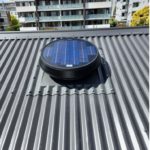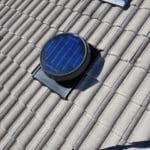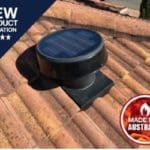Beating the heat of the hot summer months in Australia is a challenge many homeowners face but finding ways to cool down your home without running the aircon 24/7 is possible. Reducing HVAC energy costs is something most Australian homeowners strive for while searching for an alternative solution for cooling down the house on hot days. One eco-friendly option is to consider solar roof ventilation.
With the summer sun rays beating down on your house and the lack of ventilation in your roof’s cavity, trapped heat causes the indoor temperature to rise. The heat filters down into your home’s living spaces, making the rooms unbearably hot and stuffy. Keep reading to find out how to cool down your house with solar roof vents while saving on monthly energy bills at the same time.
How to Cool the House Down in Summer
Poor ventilation and trapped heat in your roof are often the reasons you have an uncomfortable, hot home during summer. Proper roof ventilation helps to reduce heat and moisture build-up. Installing solar roof vents not only improves ventilation but it’s a cost-effective solution to managing hot indoor temperatures.

How do Solar Roof Vents Actually Work?
Solar roof vents operate by using sun power, making them energy-efficient. The solar roof ventilation system works by using a highly efficient fan unit, powered by solar panels.
By pulling heat from your roof’s cavity, the solar vents improve your home’s interior temperature without you having to run your air conditioning unit, day and night. The solar roof ventilation system reduces moisture build-up too, protecting your home’s infrastructure from issues like mould.
Can Solar Vents Cool Down a House?
During the hottest Australian months, trapped heat inside your roof cavity can easily reach up to 60°C. Trapped by the roof, this hot air ends up heating up your interior rooms. Efficient solar roof ventilation systems can drastically reduce your roof cavity temperature by up to 30°C, making your home cooler during the warmer seasons.
Do Solar Roof Vents Save Money?
Using solar power, these roof vents don’t rely on the national grid for powering a ventilation system. Installation is quick and requires minimal infrastructure changes to your home’s roof, saving you money as well.
Other cost savings include:
- Damp reduction: If not controlled properly, damp conditions will cause your roof infrastructure to rot, resulting in costly repairs. Solar roof vents draw out moisture, preventing mould or mildew growth.
- Reduced heat exposure: Trapped heat damages the undersides of your roof as well as the shingles. This will lead to expensive home repairs which could be avoided by installing a solar roof ventilation system.
Solar roof ventilation systems cool down the home’s interior temperature which means your air conditioning unit doesn’t have to work as hard when running. In many cases, you won’t even need to switch on your HVAC, saving you money on your monthly energy bills.
Are Solar Roof Vents Beneficial During Winter?
You can keep your home comfortable all year round with solar roof vents. Removing trapped heat, even during the cooler months, helps you to regulate your home’s indoor temperature. But it’s equally important to ensure your roof cavity stays dry in the winter months otherwise you’ll face the same problems caused by damp conditions.
Cooking, showering, and doing the laundry all result in increased humidity levels with moisture rising up to your roof even during the colder months! Protecting your roof space during winter not only maintains the integrity of your home’s infrastructure but also reduces repair costs.
How Do I Know if I Need to Install Solar Roof Vents?
Here’s how to check if you need to install solar roof vents in your home:
- Touch the ceiling: If it feels hot, your roof is acting as an oven and trapping heat inside its cavity with no way to escape.
- Inspect the roof cavity: Checking for signs of damage such as rotting undersides, rusty nails, or blackened rafters or ceiling joists will tell you there’s a problem with ventilation in your roof.
- Trouble managing interior temperatures: If you’re struggling to regulate your home’s indoor temperature or your HVAC is battling to keep your house cool, you need to install solar roof vents.
Solar vs Wind Roof Vents: Which Option is Better?
Similar to solar roof ventilation systems, wind vents are designed to remove trapped heat in the roof cavity. However, one major difference between these two types of vents is the source of power used to operate them. A wind vent works using wind power which isn’t always available, making solar ventilation systems more efficient – there’s always sunshine even on cloudy days.
Final Thoughts
Installing solar roof vents is an eco-friendly, energy-efficient, and cost-effective approach to beating the summer heat when at home. Contact our friendly Solatube team on 13 16 19 for a free quote and let us help you make your home comfortable no matter how hot it is outside!





I’m after a quote for a solar roof ventilation system. The property is roughly 180m2 internal and I have a tile roof, it’s a single storey house and im located on the Gold Coast.
Could you please clarify the following:
• How loud is the unit when running
• What is the fan blade size
• Does it come with a thermostat, I would not want it to kick in during winter
• Cost of supply and install
• If you don’t install, do you have someone you could recommend (ballpark price usually?)
• What volume of air does it do per hour
Hi Domenica
Our Qld Specification Manager will respond to your inquiry shortly.
I found this blog post to be incredibly enlightening and informative about the functionality of solar roof vents. The explanation of how these vents operate using solar power highlights their energy efficiency, which is a significant advantage.
Understanding that solar roof vents utilize highly efficient fan units powered by solar panels to pull heat from the roof’s cavity is fascinating. The idea that these vents can improve the interior temperature of a home without the need to constantly run the air conditioning unit is truly impressive. It not only promotes energy savings but also offers a more sustainable and environmentally friendly cooling solution.
The mention of the solar roof ventilation system reducing moisture build-up and protecting the home’s infrastructure from issues like mold adds another layer of benefits. It’s reassuring to know that these vents contribute to maintaining a healthy and well-maintained living environment by addressing potential moisture-related problems.
Thank you for providing such valuable insights into the functionality and benefits of solar roof vents. This information has solidified my understanding of how they work and the positive impact they can have on home comfort, energy efficiency, and overall well-being. I will definitely consider incorporating solar roof vents into my future home improvements.
Hi I have purchased yout Solatube roof vent and would like some advise on the roof temperature settings, on temp and off temp.
Robert
Hi Robert
The Solar Star Thermal Switch will turn off the SolarStar when the temperature in the roof cavity is below 18° C and will turn on the Solar Star when the temperature in the roof cavity is greater than 29°C
What a knowledgeable blog article. Your insights on loft boarding specialists are incredibly helpful. Thanks for sharing this comprehensive guide.